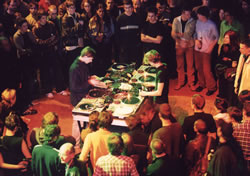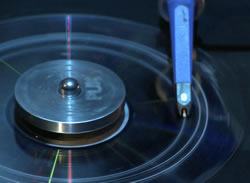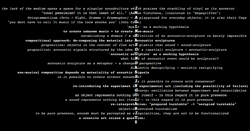Lab Report
Die 50 Skulpturen des Institut für Feinmotorik
Institut für Feinmotorik (IFF) has changed. While working on the radio piece Die 50 Skulpturen des Institut für Feinmotorik 1[1. The work was awarded the Südwestrundfunk (SWR) Karl Sczuka Prize for Works of Radio Art in 2011. Photos of the group in performance, an essay about the work by jury member Michael Grote, and the full audio of the Hörspiel broadcast from 17 January 2011 are available in the Karl Sczuka Prize archive on the SWR2 website (in German).] in 2011, IFF confronted itself with the necessity of a non-musical composition method. The concept of acoustic sculptures was chosen and implemented. Still using material from IFF’s setup of prepared turntables, the puristic method of operation has been deregulated. This process has changed our perspective on turntablism, sound and singularity.

The IFF’s instrumental setup is called Octogrammoticum (octo = eight, grammo = grammophon): a table with 8 turntables prepared with various household objects 2[2. A description of the setup, complete with photos and links to videos, is available on the IFF website, under the heading “Turntablism”.]. But it is also a sound sculpture itself, and furthermore, it is a method of sound research and performance based on reduction: the prepared turntables are played without vinyl records, audio effects or post-processing. Octogrammoticum performances / recordings are authentic in the sense that the sounds are produced by the turntables itself and the arrangement therefore reflects the direct live mix-down, not a copy-cut-and-paste session in a studio.
“Experiment” in experimental art is to be taken seriously: While in scientific experiments a falsifiable hypothesis is required, in an æsthetic experiment the criterion of falsifiability is replaced by the possibility of failure. The aim of an æsthetic experiment is not about testing a hypothesis, it is an open search for something unknown.
Description of the Experiment
The goal was to produce a radio piece out of material recorded on the Octogrammoticum. It was an experiment on two different levels, the technical and the conceptual.


Technical
During the recording session for this project (Video 1), the usual egalitarianism was abandoned and replaced by an anti-democratic but ever-changing dictatorship. For each session, the role of a conductor was assigned, who had the opportunity to use the group as his orchestra, could give commands and direct the session.
- Multi-track recording (8 tracks) was used instead of stereo recording of the live mix.
- Post-processing, editing and rearranging of recorded sound were not banned as had been standard group practice prior to this project, and the use of such techniques was encouraged.
Conceptual
The concept of the radio piece was developed during the process. As the first attempt (something like a “sound opera”) was dismissed halfway, a new concept was needed.
The idea of using a non-musical composition method was meant to manipulate our biased sonic intuitions. Trying to avoid the production of music while creating acoustic sculptures seemed to be a fertile way to explore something unknown but not arbitrary. The metaphor of spatial sculptures was chosen for an alternative way to organize, or better, to de-compose sound. While it was unclear how a spatial concept could be mapped to a time-based art, this concept gave us some vague constraints and a working method. The 50 Skulpturen… are the result of trying to propose a definition of this concept through its realization.
Results
The sculpture metaphor turned out to be fertile. The idea of sculpting, carving or de-composing sound material instead of composing music led to a collection of 49 individual acoustic sculptures. The title of the final radio piece, Die 50 Skulpturen des Institut für Feinmotorik, refers to these sculptures together with the Octogrammoticum. The order of this piece is modular, i.e. the sequential and/or parallel arrangement of the individual acoustic sculptures is variable, and they should be re-arranged (curated) for every single broadcast / presentation according to a few rules:
- At least 1 and a maximum of all 49 acoustic sculptures is / are to be used in full-length (a single sculpture can only be used once per curated version).
- Each sculpture must be kept “untouched”: the volume of each sculpture can be changed globally for its entire duration, but within a single sculpture, volume level changes panning, or any other kind of manipulation (cutting, fading, effects, time stretching, etc) are not permitted.
- The starting point for each acoustic sculpture can be chosen freely. The individual acoustic sculptures can be arranged in sequence, simultaneously or overlapping etc.
IFF has achieved a new approach to the sound material it used and still uses. The attempt to work in a non-musical manner has drawn attention to sound instead of arrangement, rhythm, narration or similar kinds of superstructures. In the past, IFF used such superstructures to give musical meaning to insignificant noise. This musical context allowed the noise sounds to evolve while new turntable preparation techniques were discovered. Now that the sounds are liberated from their subordination to musical patterns and compositions, they are perceived as singularities that can stand for themselves. IFF experiences this as a kind of inversion of the direction of their research. For IFF, working beyond the Octogrammoticum and its strict rules opens a field of possibilities.
Discussion

Although the question about “what is music / how to create non-music” is nonsense (especially after the 20th century of transgressive avant-gardes), it is useful as a working hypothesis for composition. It does not seem to be useful as an ontological term, but it allows artists to think differently about production processes and blind spots. Trying to obtain “unknown” results by attempting to work in an unusual way does not necessarily mean to do something arbitrary. Transferred concepts from different domains can serve as a guide. The concept of sculptures that IFF has used isn’t new in musical contexts, and IFF realizes that it is generally used in different ways: the Octogrammoticum, for example, is a sound sculpture, a (spatial) sculpture which makes sound. But the sculptures that were produced for the radio piece are completely made of sound, and only their structure is inspired by the form of a spatial sculpture. Thus IFF proposes the following distinction:
- Sound sculpture: Objects in the field of fine arts plastic that sound;
- Acoustic sculpture: Organization of acoustic signals based on the idea of a (spatial) sculpture.

According to this distinction, the 50 Skulpturen des Institut für Feinmotorik are acoustic sculptures based on recordings of a sound sculpture. This constellation could be called a second-order acoustic sculpture…
To describe the experience IFF made during this experiment, a paraphrase of Nietzsche’s “eternal return” seems to be appropriate: Imagine you would build an instrument that can be used only once. It would produce one sound and destroy itself while doing so. You cannot record the sound; you will hear it only once. What would you like this sound to be? Nice? Beautiful? A surprise? “Interesting”? Something similar to what you already know? — Imagination of a sound as singularity.
Social top